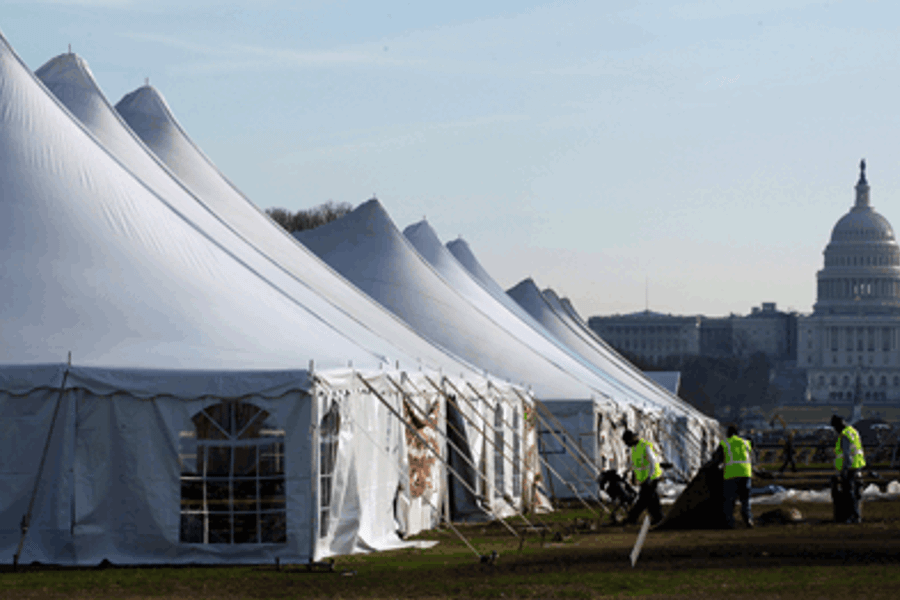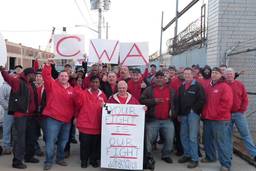
Many people are surprised to learn that my roommate is a Washington D.C. cop. When Occupy DC started in early October, my roommate told me that personally he found the occupiers in McPherson Square quite friendly and that, while he thought some of the people were crazy, he was quite sympathetic to what they are doing.
Relations between police and occupiers in DC had been initially friendly, with Park Police issuing statements that they had no intention to vacate the park. DC Park police and the occupiers were able to negotiate a de facto arrangement whereby protesters were allowed to stay in the park as long as they obeyed basic rules.
Then on December 4, occupiers broke this truce by attempting to construct a giant barn in the park so they could hold general assemblies and other events while protected from the elements. Police quickly swept into stop the construction, declaring the barn unsafe and ordering it to be taken down. Protesters occupied the barn and stood on its roof in protest. After a nine-hour standoff, they were arrested.
My roommate was quick to denounce the protesters. “It’s a public park for everybody. One group just can’t go constructing something in it and limiting other people’s ability to use the park. People like my parents who are on the fence aren’t going to sympathize with people doing stuff like that.”
The fight over the barn symbolizes a growing problem: Occupy is seen as a movement fighting police over usage of public space, rather than a movement fighting inequality, corporate corruption, etc. The debate over social movements being able to use public space is important, but it is a debate far removed from the day-to-day material concerns of most people’s lives.
This tension over the direction of the Occupy movement was on display December 7, when a handful of Service Employee International (SEIU) union member protesters argued with Occupy protesters and tried to stop them from laying down and blocking K Street in order to make a political statement. At one point, Occupy DC protesters during march started chanting at SEIU to “go away” and one Occupy DC Protester even stole a flag off of SEIU protesters.
The SEIU activists’ reasons for opposing that act of civil disobedience were unclear to me, but it may have had to do with the fact that the union was involved with other acts of protest in the city that day. SEIU and other progressive groups like Center for Community Change and Van Jones’ Rebuild the American Dream bused in protesters from all over the U.S. for a four-day long “Occupy Congress.” The organizations set up massive, high-quality tents replete with power generators. SEIU activists may have wanted the protesters to march with them to tents on the national mall for a series of events on the jobs crisis, instead of getting arrested.
In contrast to the arrests that day on K Street, nobody got arrested during the massive Wisconsin State Capitol occupation early this year, even when protesters defied police orders. The cops wouldn’t arrest protesters in Madison because many — including the police — empathized with what the protesters were advocating.
While there were divisions among protesters over the need for general strikes or whether work-to-rule tactics should be employed to fight Walker’s anti-union bill, people nevertheless worked together in Wisconsin to achieve some very real results: union and community activists forced the largest bank in Wisconsin, M&I bank, to declare that it would no longer fund candidates who attack workers’ rights; protesters galvanized rank-and-file participation in unions; they have successfully recalled of two state senators and have launched an unprecedented recall campaign against Governor Scott Walker; and Wisconsin’s protestors inspired many of the ground troops who successfully repealed union-busting legislation in Ohio.
Some solidarity between the union and social justice movements was evident last week as purple-clad SEIU protesters fought alongside Occupy protesters on K Street, but it was clear that there were divisions between SEIU and Occupy DC protesters. (And this week, divisions became evident between Occupy activists on the West Coast and the longshoremen’s union, which I wrote about here.)
Many Occupy DC protesters are weary of getting involved in union-driven politics that often target Republicans, but not Democrats, even when both parties are equally complicit in a problem.
As I watched SEIU and Occupy Wall Street protesters argue over whether or not to lay down in the middle of the road or march to some expensive tents on the mall for a few scripted events, it struck me that both groups, while pursuing social and economic justice, were backing into an unproductive cul de sac.
When left-wing activists grow frustrated about their inability to make political change in America’s political system, they often turn on each other instead of moving toward nonpolitical (i.e., non-legislative) ways of changing economic issues. As longtime Nation political correspondent William Greider described it to me recently, Congress has become a “political dead zone,” meaning that neither conventional nor more radical politics is going to change it any time soon, but over time, by building unity and solidarity, perhaps people will be able to change it.
Progressives often tend to focus on economic change from a macro level of national or state politics, but there are other ways to make change: organizing workers or fighting foreclosures that can force companies to change their practices from the bottom-up. By organizing workers and consumers, the left can change the power dynamic of the U.S. economy by placing economic power in the hands of the citizenry instead of in the hands of politicians.
The day before SEIU protesters and Occupy DC protesters debated each other, Occupy Wall Street protesters and members of some SEIU locals in New York City were working harmoniously together to move a previously homeless family back into a foreclosed home.
Activists and supporters helped move the family back into the previously vacated home, even bringing a Christmas tree and presents. The event attracted mass public support and lots of media attention as it’s difficult to be against giving a family a home. Even my cop roommate was moved by the action.
The Occupy Our Homes movement is promising for two reasons: 1) home occupations are difficult for cops to oppose, and 2) it could be a model for uniting various factions of the left. Whatever stops union members and Occupy activists from arguing is a good thing.





